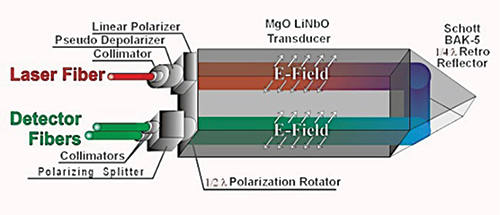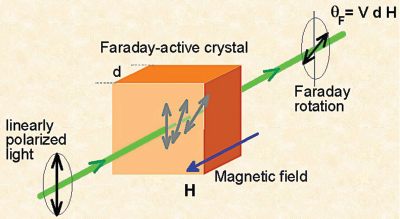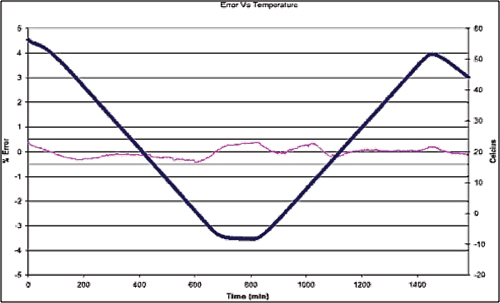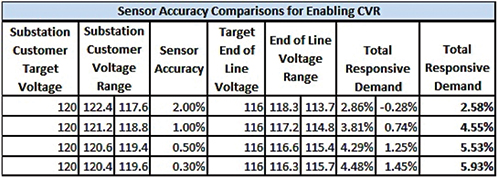To meet regulatory, business and customer satisfaction demands, utilities are seeking more effective technologies to reduce peak loads to improve reliability and to effectively make the right operating and maintenance investments. Medium voltage (MV) optical current and voltage sensors, as a next generation instrument transformer, meets these challenges.
MV Optical Current & Voltage Sensor Design
To manage the challenges of 21st century demand, the power grids of the future must enable intelligent communication across sensing, measurement, and control layers.
As a next-generation instrument transformer with very high dynamic current range, best-in-class accuracy, and high frequency response, MV optical current and voltage sensors facilitate the effective control of the distribution systems through real-time measurement of voltage and current.
Next generation optical sensors measure voltage and current using specially engineered crystals with light passing through fiber optic cables.
Sensor voltage measurement uses the Pockels Effect. When the light passes through the crystal inside the electric field the light polarizes proportionally to the electric field strength.

Fig. 1 – Pockels Effect Schematic
Similarly, the Current measurement uses the Faraday Effect by rotating the polarization of the light in proportion to the magnetic field strength.

Fig. 2 – Faraday Effect Schematic
The integral of the magnetic field surrounding the conductor has to be measured to eliminate adjacent line magnetic interference and provide a universal solution regardless of the type of cable. This is accomplished with the use of a magnetic concentrator.1
Why Optical MV Sensors Are Considered Next Generation Instrument Transformers
To optimize energy efficiency applications such as Demand Response and Volt/VAR control, a MV sensor or instrument transformer with high accuracy is required.
For Fault Detection and Service Restoration applications, high dynamic current range and real time response are required.2 For Power Quality applications, the most important data measurement features are high frequency response and very high signal sampling rate.
MV optical current and voltage sensors deliver:
- Very High Accuracy: Measuring 15,000 times per second, optical MV sensors are accurate within ±0.5% in the outdoor environment from -25C to +70C
- High Dynamic Range: The MV optical sensor can measure near-DC signals and beyond 20 kA – a feature impossible with instrument transformers. The high dynamic range eliminates the need for parallel current transformers.
- Versatility: The optical sensor’s lightweight design and isolated path to the electronics enable the sensors to be easily and economically installed along feeders – delivering accurate real time system information for more informed decision-making.
- Flexibility: Optical sensors are applicable across the full range of medium voltage systems. The same sensor and electronics can often be used for multiple situations reducing inventory, minimizing training, and simplifying maintenance.

Fig. 3 – Accuracy of ±0.5% over Time and Varying Temperature
Optical MV Sensor Performance across Alabama Power’s Distribution System
Alabama Power, part of Southern Company of Atlanta, Georgia USA, has been evolving its Distribution Automation system since 1989.3
Through a cooperative research and development program with the Electric Power Research Institute (EPRI) in a project known as Green Circuits, Alabama Power demonstrated that energy efficiency improvements and voltage management techniques could reduce energy demand.4,5
To maximize the efficiency opportunities, Alabama Power found it imperative that information about the distribution feeders be available for each phase and at multiple locations on the feeder.6,7 Alabama Power decided that this could be best accomplished by using instrument transformers (MV sensors) to:
- Balance the loads equally between the phases on the three phase feeders
- Improve the feeder’s power delivery efficiency (power factor)
- Level the feeders’ voltage profile from the substation breaker to the end of the line
- Lower the voltage setting at the substation
To ensure accurate information, Alabama Power used one sensor per phase and three or more sets of sensors per feeder.
Significant Voltage and Efficiency Improvements
Deploying post type MV current and voltage sensors, Alabama Power captured a one percent reduction in voltage (on average) at the MV substation. The field trial provided an efficiency improvement of the delivery of power between 2.01 to 2.14 percent.
With higher precision sensors this performance can be improved. As can be seen in Figure 4, a higher accuracy sensor enables the utility to increase demand response capacity while meeting the consumer ANSI C84.1 requirement for delivery between 114V and 126V.

Fig. 4 – Sensor Accuracy effects on Responsive Demand
Benefits of MV Optical Sensors
MV sensors can detect which feeder line segment has had a fault. The remote control of line switches allows the opening of switches on either side of the fault to isolate it. Subsequently service can be restored to the un-faulted sections by reenergizing the un-faulted sections by remotely closing breakers, line reclosers and line switches. This action greatly reduces the outage time to those customers not in the isolated line segment.
The increased functionality of the optical sensor also provides more accurate line flow values. This information delivers more accurate calibration factors for the line’s power flow analysis program.
Prioritizing O&M Investment
Typically, line power flow analysis (LFA) is the basis for determining future system improvements and for allocating capital budget funds. Having more accurate data assures that capital budget dollars will be allocated where most needed. More importantly, accurate data ensures that capital investment will not be allocated where it’s not needed.
If utilities are to conquer the challenge of increased energy demand, contrasted with energy efficiency mandates, they must seek new, more effective technologies. Deploying optical MV current and voltage sensors across differing voltage systems and configurations offers dynamic system operation, improved efficiency, and increased reliability.
Any extension of asset life and increased control of field equipment offers significant financial impact. As an early adopter of MV sensors, Alabama Power has used this real-time data to target resources, improve system reliability, and more accurately manage its loads across their service territory.
“Utilities are seeking options to better manage demand, resources, and infrastructure costs,” says Trey Beasley, P.E. of OptiSense Network.
“Having real-time voltage, current and power factor data allows utilities like Alabama Power to effectively manage the efficiency, reliability and demand response of their distribution systems.”
About the authors
 Don Parker, P.E. has more than 40 years of experience in distribution automation, power quality and reliability, and intelligent devices. Don currently serves as Principal Engineer with Alabama Power, a Southern Company. Don is a member of IEEE Power Engineering Society with active participation on the Switchgear Committee, Power System Relay Committee and Surge Device Protection Committee. He has served as Technical Advisor on numerous projects with NEETRAC. His presentations on MV Optical Sensors, CVR and VV include DistribuTECH 2012, IEEE ISGT 2012, and IEEE PES GM 2011.
Don Parker, P.E. has more than 40 years of experience in distribution automation, power quality and reliability, and intelligent devices. Don currently serves as Principal Engineer with Alabama Power, a Southern Company. Don is a member of IEEE Power Engineering Society with active participation on the Switchgear Committee, Power System Relay Committee and Surge Device Protection Committee. He has served as Technical Advisor on numerous projects with NEETRAC. His presentations on MV Optical Sensors, CVR and VV include DistribuTECH 2012, IEEE ISGT 2012, and IEEE PES GM 2011.
 Trey Beasley, PE., MBA is a licensed Professional Engineer with more than twenty years of utility industry experience. Holder of two patents on power delivery methods, Trey was instrumental in planning, project management, operations and maintenance of power systems at TXU Energy. While there, Trey managed TXU’s renewable technology showcase – one of the nation’s first solar and wind generation proof of concept test sites. TXU is now one of the largest purchasers of renewable energy in the USA.
Trey Beasley, PE., MBA is a licensed Professional Engineer with more than twenty years of utility industry experience. Holder of two patents on power delivery methods, Trey was instrumental in planning, project management, operations and maintenance of power systems at TXU Energy. While there, Trey managed TXU’s renewable technology showcase – one of the nation’s first solar and wind generation proof of concept test sites. TXU is now one of the largest purchasers of renewable energy in the USA.
Formerly the Director of Channel Alliances with Oracle Utilities, Beasley serves as Vice President of Business Development at OptiSense Network LLC. He holds a Bachelor of Science in Electrical Engineering from Texas A&M University and an MBA and a Masters of Finance from the University of Texas at Dallas. Trey is an IEEE member.
1 Shuping Wang; Avinash Karri; Yossi Harlev “Use Of Dual-Frequency Excitation Method to Improve the Accuracy Of an Optical Current Sensor,” SPIE: 21 August 2009
2 G. Larry Clark, “Fault Detection, the Eyes and Ears for the Distribution Operator”, DistribuTECH 2002 Conference & Exhibition, February 27 – March 1, 2002, Miami Beach, Florida.
3 G. Larry Clark “Distribution Automation – 15 Years of Experience at Alabama Power” Feb, 8, 2006
4 EPRI Green Circuits Project Launched T&D World May 1, 2010
http://tdworld.com/overhead-distribution/epri-green-circuits-project-launched
5 Green Circuits Through Voltage Control T&D World May 1, 2010
http://tdworld.com/overhead-distribution/green-circuits-through-voltage-control
6 Distribution Systems Get Efficiency Upgrades T&D World Feb 1, 2010
http://tdworld.com/overhead-distribution/distribution-systems-get-efficiency-upgrades
7 Alabama Power and Duke Energy Realize Efficiency Gains Through Green Circuits Project
http://www.optisense.net/wp-content/uploads/2011/11/PDU-Success-Story-Alabama-and-Duke-Green-Circuits-1024731.pdf







